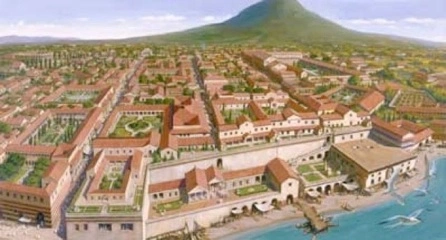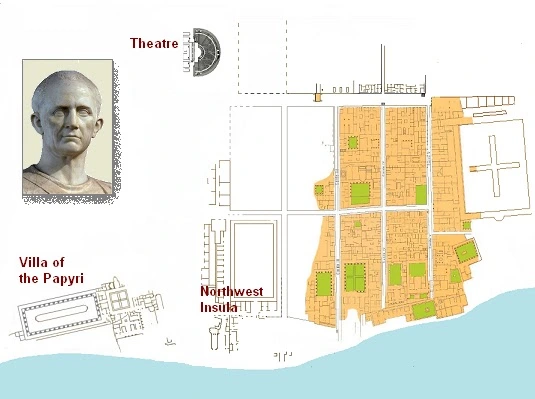Herculaneum
Embark on a captivating exploration of the Roman city of Herculaneum through our meticulously crafted digital map. Immerse yourself in the splendors of this ancient city that thrived in the shadow of Mount Vesuvius, capturing the essence of daily life in the Roman world.

Our interactive map invites you to traverse the well-preserved streets and squares of Herculaneum, providing a detailed representation of its layout and architectural wonders. From the grandeur of public buildings to the intimacy of residential areas, each corner of the city unfolds with historical significance.
As you navigate through the digital streets, discover the intricate details of houses, taverns, baths, and temples. Zoom in to explore the preserved frescoes and mosaics that adorned the walls of these ancient structures, offering a glimpse into the artistry of Roman life.
Markers throughout the map provide historical insights, allowing you to learn about the purpose and significance of each site. Whether you’re drawn to the opulent House of the Deer, the well-preserved carbonized remains of wooden furniture, or the thermal baths that were central to Roman social life, our map serves as a gateway to understanding Herculaneum’s rich history.

Experience the Roman city of Herculaneum as never before, unraveling its secrets through an immersive digital journey. This map is not just a visual recreation but a tool for historical exploration, offering a dynamic perspective on the urban planning and cultural heritage of this archaeological treasure.
Step into the past and witness the legacy of Herculaneum through our digital map. Uncover the stories embedded in its ruins and let the history of this remarkable city come to life in the digital realm.
For scholarship on the city see the Herculaneum Reading List.
Glossary
- Ala – Wing or alcove opening to left and/or right of the atrium of a Roman house.
- Apodyterium – A changing room of a Roman baths.
- Ara – An altar.
- Atrium – The main hall of a Roman house.
- Augustales – local officials, usually freedmen, appointed in various towns for the worship of deified emperors.
- Basilica – Colonnaded public hall on the Forum, used for commercial transactions and dispensing of justice.
- Caldarium – The hot room of a Roman baths.
- Caupona – An inn or tavern, which served hot food.
- Compluvium – An opening in the roof, which had below it, a water tank (impluvium) in the atrium floor.
- Cubiculum – A bedroom.
- Domus – A house within a city.
- Fauces – Entranceway to a house, leading to the atrium.
- Frigidarium – The cold room of a Roman baths.
- Hospitium – Inn or lodgings.
- Impluvium – A water tank on the floor of the atrium, which had directly above it, an opening (compluvium) in the roof.
- Lararium – A shrine to the household gods.
- Nymphaeum – A ornamental fountain.
- Oecus – The main living room of a Greek house, introduced to Roman architecture along with the peristyle. Often used for dining.
- Palaestra – An open area surrounded by covered porticoes used for wrestling and exercise, often forming part of a Roman bath complex.
- Peristyle – An open courtyard or garden surrounded by a colonnade.
- Pistrinum – A bakery or mill.
- Posticum – A house’s second entrance, or backdoor.
- Sacellum – A shrine.
- Taberna – A shop.
- Taberna Textorum – A fabric shop.
- Taberna Vinorum – A wine shop.
- Tablinum – A study.
- Templum – A temple.
- Tepidarium – The warm room of a Roman baths.
- Theatrum – A theatre
- Thermae – Roman bath complex.
- Triclinium – A dining room.
- Villa – A house in the country.
